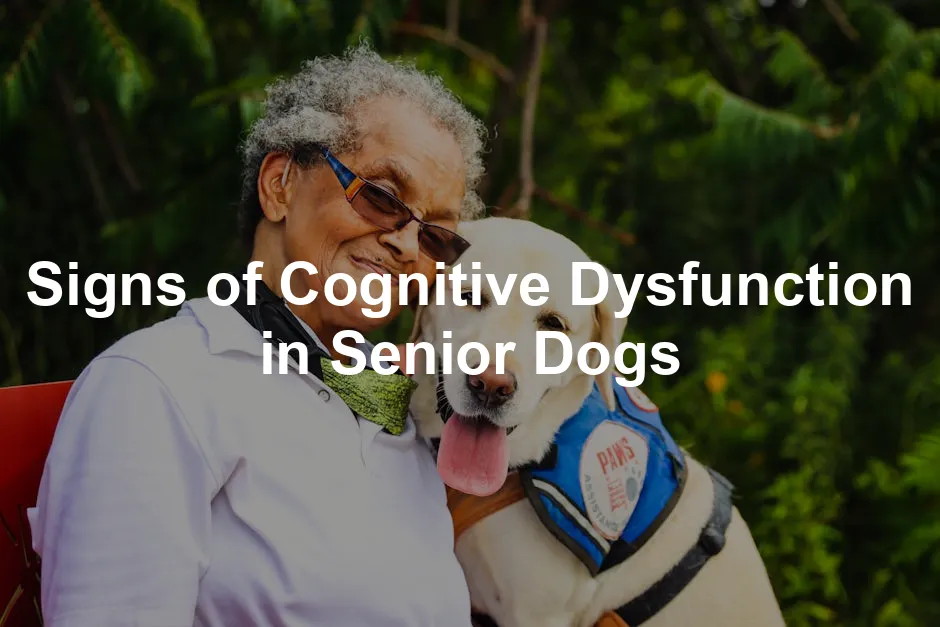Introduction
As our furry friends age, they may experience cognitive dysfunction syndrome (CDS), a condition often likened to dementia in humans. Just like us, senior dogs can face challenges in memory, learning, and behavior. Recognizing these changes early is crucial. Spotting the signs of cognitive decline can lead to timely interventions, ultimately improving the quality of life for your beloved pet.
In this article, we aim to inform dog owners about the signs, causes, diagnosis, and management of cognitive dysfunction in senior dogs. Understanding this condition can empower you to make informed decisions for your furry companion, ensuring they receive the care they need as they navigate their golden years.
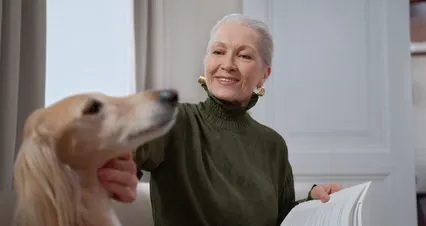
Understanding Canine Cognitive Dysfunction
What is Canine Cognitive Dysfunction?
Cognitive dysfunction syndrome (CDS) is a progressive condition that affects dogs as they age. It’s characterized by a decline in cognitive abilities, similar to the cognitive decline seen in Alzheimer’s disease in humans. Dogs with CDS may display significant changes in their memory, behavior, and learning capabilities.
Statistics reveal that this condition is more common than many pet owners realize. Approximately 28% of dogs aged 11-12 years show at least one sign of cognitive dysfunction, and this number skyrockets to 68% for dogs aged 15-16 years. These figures highlight the importance of recognizing early signs and seeking veterinary care to manage the condition effectively.
Aging dogs may exhibit various symptoms that progressively worsen over time. These can include disorientation, changes in interactions with family members, sleep disturbances, inappropriate elimination, and alterations in activity levels. Each sign can deeply affect your dog’s quality of life, making early recognition and intervention pivotal.
Being aware of these signs can help you spot potential cognitive dysfunction in your senior dog, allowing you to provide the best care and support as they navigate the complexities of aging. Making adjustments to their environment, routine, and care can greatly benefit their well-being. For instance, consider a PetSafe Busy Buddy Bristle Bone Dog Toy for some fun engagement!
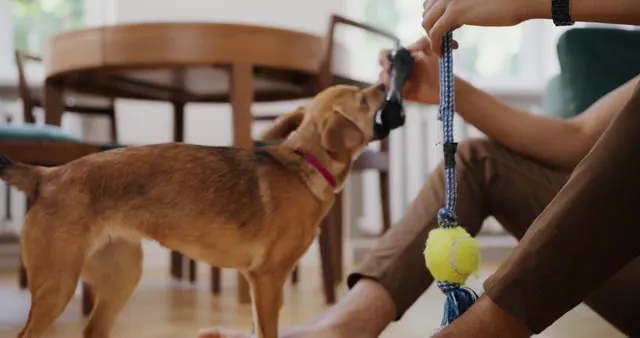
Signs of Cognitive Dysfunction
Common Signs and Symptoms
As our beloved pups age, they may start to show signs of cognitive dysfunction. Recognizing these symptoms early can lead to better management and support for your furry friend. To help identify these signs, we can use the DISHAA acronym.
Disorientation: This is often the first sign pet owners notice. Dogs may become confused in familiar environments, wandering aimlessly or getting stuck in corners. For instance, your dog might forget where the back door is or just stare at a wall like it’s the most fascinating thing ever. It’s both concerning and a little amusing.
Interaction changes: Dogs might suddenly become clingy or, conversely, more aloof. You may find your pup ignoring you when you call or acting as if they don’t recognize you. Imagine a dog that used to greet you with a wagging tail now giving you the cold shoulder. It’s a puzzling turn of events, indeed!
Sleep-wake cycle changes: Increased nighttime activity can disrupt your sleep too. Your dog might start pacing the house at 2 a.m. wanting to play. It’s like having a furry party planner who’s forgotten about the time. You might find yourself wide awake, wondering why your furry friend has suddenly turned nocturnal.
House soiling: Inappropriate elimination can occur even in previously house-trained dogs. If your dog starts having accidents indoors, it might be a sign of cognitive dysfunction. You might think they’re just being naughty, but they might genuinely forget their potty training. Frustrating? Absolutely!
Activity level changes: Dogs may lose interest in activities they once loved. An enthusiastic fetch player may suddenly prefer to lounge on the couch all day. You’ll find that favorite ball gathering dust as your pup seems perfectly content to snooze instead. It’s like the life of the party has suddenly gone home early.
Anxiety: Increased anxiety or irritability is common. Your once laid-back pooch may suddenly bark at every little noise or be scared of things that never bothered them before. You might notice them pacing or whining. It’s heartbreaking to see your dog turning into a furry worrywart.
To illustrate these signs, let’s consider Bella, a 12-year-old Golden Retriever. Bella used to be the queen of fetch, eagerly chasing her ball for hours. Recently, her owner noticed Bella getting lost in the backyard, wandering around as if she didn’t know where she was. Bella now prefers to nap rather than engage in play. Her owner also noticed Bella sometimes barking at shadows or becoming anxious during thunderstorms. These changes are not just part of aging; they indicate a deeper issue.
By understanding these signs and their implications, pet owners can take proactive steps. If you notice your dog exhibiting these symptoms, consider consulting with your veterinarian. Early recognition of cognitive dysfunction can lead to better management strategies and a more comfortable life for your beloved canine companion.

For more insights on caring for senior dogs, you can check out the best practices for caring for senior dogs with mobility issues here.
Diagnosis of Cognitive Dysfunction
Veterinary Evaluation
Diagnosing canine cognitive dysfunction syndrome (CDS) involves a multi-faceted approach. First, your veterinarian will gather a detailed history of your dog’s health. This includes understanding the onset and nature of any concerning behaviors. Owners play a crucial role here. Observations about changes in behavior, routines, and interactions can provide essential clues.
Next, a thorough physical examination will take place. This is vital to rule out other health issues that may mimic cognitive dysfunction. Blood tests, urinalysis, and imaging techniques like X-rays are often employed. They help identify conditions such as infections, organ dysfunction, or even tumors. After all, we want to ensure that your dog’s symptoms aren’t just a case of a bad hair day!
Your veterinarian might also use cognitive dysfunction rating scales to measure the severity of symptoms. These scales can help quantify the impact of cognitive decline on your dog’s quality of life. They typically involve a series of questions related to the DISHAA acronym: Disorientation, Interaction changes, Sleep-wake cycle alterations, House soiling, Activity level changes, and Anxiety. Each category provides insights into your dog’s cognitive state.
Importance of Early Detection
Early detection of CDS is like finding the last piece of a jigsaw puzzle—critical for effective management! Recognizing symptoms sooner rather than later can lead to better outcomes for your dog. With timely intervention, you can slow the progression of the disease and improve your pet’s quality of life.
Moreover, overlapping symptoms can lead to misdiagnosis. For instance, conditions like arthritis, diabetes, or even thyroid issues can mimic cognitive dysfunction. A comprehensive evaluation helps distinguish between these conditions.
When you notice changes in your dog’s behavior, don’t just shrug it off as “getting old.” Equip yourself with the right information before your vet visit. Document specific behaviors and any changes in your dog’s routine. This data can be invaluable during discussions with your veterinarian. The more details you provide, the more accurate the diagnosis and treatment plan can be.
In summary, understanding the diagnostic process is essential. It’s not just about identifying CDS; it’s about ensuring your dog receives the best care possible. Early detection and thorough evaluation can significantly impact your dog’s cognitive health and overall well-being. With the right approach, you can help your furry companion navigate the challenges of aging with grace and dignity.
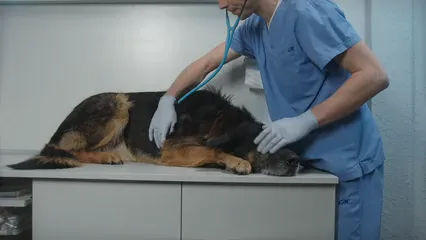
Management and Treatment Options
Non-Medical Interventions
Managing cognitive dysfunction syndrome (CDS) in senior dogs requires a blend of lifestyle adjustments and medical interventions. Let’s break this down into non-medical interventions, medical treatments, and the importance of ongoing veterinary support.
Implementing lifestyle changes can significantly improve your dog’s quality of life. Here are some effective strategies.
Establish a Consistent Daily Routine
Dogs thrive on routine. A predictable schedule for feeding, walks, and playtime can help your dog feel more secure. It’s like giving them a comforting hug every day. A consistent routine reduces anxiety and confusion, making your pup feel more grounded. Think of it as a doggie version of a well-planned day—no surprises!
Environmental Modifications
Creating a safe and comforting environment is crucial. Start by decluttering your space. Remove obstacles that might confuse or frustrate your dog. Ensure that they have safe spaces to retreat when feeling overwhelmed. Consider using night lights to illuminate pathways. A well-organized home can prevent your dog from getting lost in familiar surroundings, making them feel more at ease. And while you’re at it, a PetFusion Ultimate Dog Bed can provide a cozy retreat for your pup!

Mental Stimulation through Interactive Toys and Games
Keep your dog’s mind sharp with engaging toys. Puzzle feeders and interactive games can provide the mental stimulation they need. Think of it as a workout for their brains! Activities like hide-and-seek with treats can also be fun. Engaging their senses helps slow cognitive decline and keeps boredom at bay. Plus, it’s a great way for you both to bond! Consider the Outward Hound Hide-A-Squirrel Puzzle Toy for some fun challenges!
Medical Treatments
While lifestyle changes offer support, some dogs may need medical intervention. Here are common options that veterinarians may recommend.
Selegiline (Anipryl)
This prescription medication enhances neurotransmitter function in the brain. It helps slow the progression of cognitive decline. Think of it as a little boost for your dog’s brain! Many dog owners notice improvements in their pets’ behavior and overall mood after starting this treatment.
Supplements
Certain supplements can support cognitive health. S-adenosylmethionine (SAM-e) and omega-3 fatty acids are popular choices. They’re like vitamins for your dog’s brain! Zesty Paws Omega 3 Salmon Fish Oil for Dogs can be a great addition to their diet!
Prescription Diets
Specialized diets formulated for cognitive support can make a difference. Brands like Hill’s Prescription Diet B/D and Purina Pro Plan Bright Mind are designed to provide nutritional support for aging brains. These diets are rich in antioxidants and fatty acids, promoting cognitive health. Consider them as brain food for your furry friend!
Ongoing Veterinary Support
Regular veterinary check-ups play a pivotal role in managing CDS. Your veterinarian will monitor your dog’s condition, adjusting treatment plans as needed. Regular assessments allow you to stay proactive and ensure the best quality of life for your pet. Just like you would for your own health, keeping your dog’s medical appointments is essential.
Your vet can also help identify any new symptoms or changes in behavior. This ensures that any potential complications are addressed promptly. Remember, you’re not alone in this journey! Your veterinarian is a valuable partner in navigating the challenges of cognitive dysfunction.
In conclusion, managing cognitive dysfunction in senior dogs involves a combination of lifestyle adjustments and medical interventions. By creating a structured routine, modifying the environment, providing mental stimulation, and seeking veterinary support, you can help your beloved pup live a fulfilling life. With the right strategies, you can make their golden years truly shine!
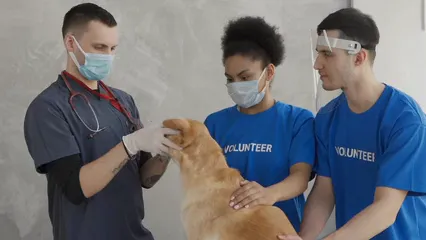
Conclusion
Recognizing the signs of cognitive dysfunction in senior dogs is vital for their well-being. As dogs age, they can experience cognitive decline similar to dementia in humans. Early detection can lead to timely veterinary intervention, which can significantly improve your dog’s quality of life.
Dog owners should watch for subtle changes in behavior, such as disorientation, altered interactions, or changes in sleep patterns. These signs may seem minor but can indicate a more serious issue. Keeping a close eye on your furry friend and maintaining open communication with your veterinarian is essential.
With proper management, many dogs can maintain a good quality of life despite cognitive challenges. From environmental modifications to medications, there are various strategies to support your dog’s cognitive health. Remember, a little extra attention and care can go a long way in enhancing your aging dog’s happiness and comfort. A Furbo Dog Camera can also help you keep an eye on your pup while you’re away!
Together, you and your vet can navigate these changes, ensuring your beloved pet continues to enjoy life to the fullest.
FAQs
What age do dogs typically start showing signs of cognitive dysfunction?
Dogs typically start exhibiting signs of cognitive dysfunction around the age of nine, but this can vary based on breed and size. Research indicates that approximately 28% of dogs aged 11 to 12 years show at least one sign of cognitive dysfunction. This prevalence increases significantly with age; about 68% of dogs aged 15 to 16 years exhibit symptoms. Smaller breeds may show signs later than larger breeds, making it essential for all dog owners to be vigilant, regardless of their pet’s size.
How can I help my dog with cognitive dysfunction at home?
Enhancing your dog’s environment can significantly improve their quality of life. Establish a consistent daily routine, including regular feeding and exercise schedules. This predictability can reduce anxiety and confusion. Consider decluttering your home to create a safe space for your dog, minimizing the chances of getting lost or stuck. Engaging your dog with interactive toys and puzzles can stimulate their mind and keep their cognitive functions active. Lastly, ensure your dog has easy access to their favorite resting spots and bathroom areas to reduce stress.
Is cognitive dysfunction reversible?
Cognitive dysfunction is a progressive condition and is not considered reversible. While there are treatments available to manage symptoms and potentially slow the progression, such as medications and lifestyle changes, the underlying degenerative processes in the brain cannot be reversed. The focus should be on providing supportive care to enhance your dog’s quality of life and comfort as they navigate this challenging condition.
When should I consider euthanasia for my dog?
Deciding on euthanasia is one of the most challenging decisions a pet owner faces. It’s important to consider your dog’s quality of life. If your dog shows persistent signs of distress, severe disorientation, or is unable to enjoy their favorite activities, it may be time to consult your veterinarian. They can help assess your dog’s condition and discuss options, ensuring you make a compassionate decision based on your pet’s best interests.
Are there any specific breeds more prone to cognitive dysfunction?
While cognitive dysfunction can affect any breed, research suggests that certain breeds may be more prone to developing symptoms. Larger breeds, such as German Shepherds and Golden Retrievers, often show signs of cognitive decline earlier than smaller breeds. Some studies indicate that mixed-breed dogs may also be at risk. It’s crucial for owners of all breeds to monitor their pets for signs of cognitive dysfunction as they age, regardless of breed predisposition.
Please let us know what you think about our content by leaving a comment down below!
Thank you for reading till here 🙂
All images from Pexels

